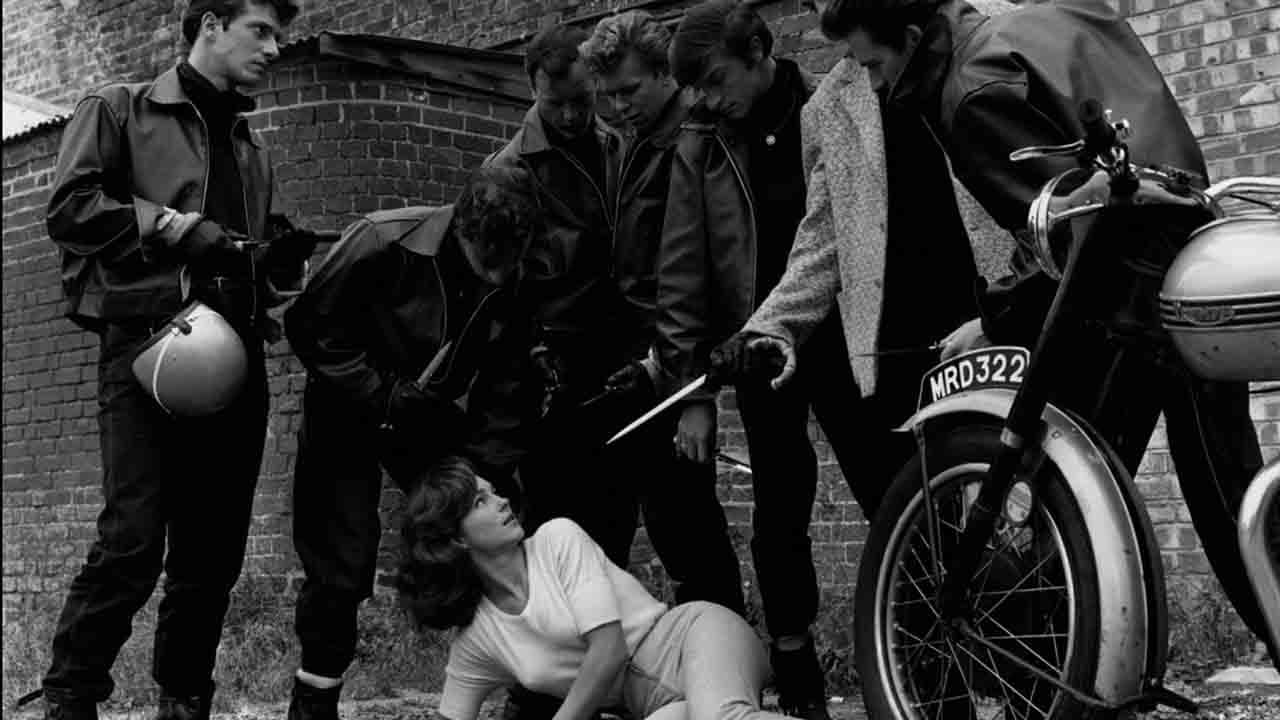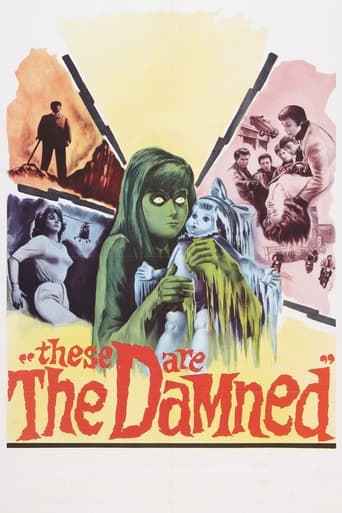

The middle-aged American Simon Wells (Macdonald Carey) sails in his boat to Weymouth and stumbles with the twenty year-old Joan (Shirley Anne Field) on the street. He believes that she is a prostitute but she is actually part of a scheme of a motorcycle gang to rob tourists. Simon is brutally beaten up by her brother King (Oliver Reed) and his gang. The policemen find the wounded Simon and take him to a bar to recover, where he meets the military Bernard (Alexander Knox) and his mistress Freya Neilson (Viveca Lindfors). On the next morning, Joan challenges King and meets Simon in his boat, and King and his gang hunts Simon down. Joan and Simon spend the night together in an isolated house and on the morning, they are located by the gang. They try to flee and stumble in a top-secret military facility managed by Bernard. They are helped by children and brought to their hideout in a cave. King falls in the sea while chasing the couple and is also helped by a boy and brought to the same place. Soon Joan finds that the children are cold as if they were dead. What is the secret of the children and the military staff?"The Damned" is a creepy sci-fi with a very dark and hopeless conclusion in the summit of the Cold War. In this period, people were paranoid with nuclear attack and the British research in understood by those that lived in that period. My vote is seven.Title (Brazil): "Malditos" ("Damned")
... View MoreFor decades we have been living with the cult of the director, but in Hollywood they will tell you only two things really matter on a picture: the screenplay and the casting. Get those two things right and any competent director can make a good movie. Get them wrong and a great director might make the movie watchable but he can't make it good.After watching The Damned, who can doubt that Hollywood is right and movie critics are wrong? Joseph Losey was a very good director, but this movie scarcely rises to the level of the watchable.The casting is desperate. McDonald Carey was 47 (and looks older) so his wooing of Shirley Anne Field was just creepy.She in turn was a tad too old to be playing a teenager. Her acting at that time was famously a bad joke. In the Damned she doesn't actually fluff her lines, but that is about it. Her accent is all over the place.Oliver Reed is a personal aversion of mine. In his early days, he always gave the same intense, brooding performance irrespective of the character or the tone of the picture. His acting was pure narcissism: second division Marlon Brando.Kenneth Cope was nearing thirty but looked younger so often got saddled with teenage roles like this. As a nihilistic thug, starting to have doubts about his life, he is laughable.Viveca Lindfors was a decent actress but has nothing to work with. What was her character doing in this picture?The kids couldn't act.The screenplay is a mess. It was cobbled together in two weeks when Losey rejected the script he had been given. It is no surprise that nothing hangs together and nothing connects properly.The premise is ridiculous. Breeding kids who are naturally radio-active in order that they could survive after a nuclear war gives a whole new meaning to 'playing the long game'. That they could also be cold-blooded is scientific nonsense and an insult to any audience that could be expected to take this film seriously. If you want to say something about Cold War hysteria, you should at least try to make it faintly plausible and pertinent.Clearly there is an attempt to draw a parallel between the casual violence of the gang and the purposive violence of the bureaucrats, but this is compromised by the 'softly softly' approach of the military to the breach of security at the research complex. The authorities seem to be behaving with commendable restraint, so the execution of the artist by Bernard is totally discordant with anything seen before.The gang are constantly called Teddy Boys, a phenomenon of the early Fifties, although they are clearly 'Rockers' or 'Greasers'. However, this is not necessarily and error on Losey's part. It is plausible that middle-aged men would not be abreast of the fine distinctions of youth culture and would use an anachronistic term.Other reviewers have noted some parallels with A Clockwork Orange but this must have been purely accidental. The film could not have been drawing on the book for inspiration since it had not yet been published. Similarly, I very much doubt if Anthony Burgess ever saw the movie, much less was influenced by it.I am tempted to say that any film by Joseph Losey is of some interest, but The Damned tests that proposition almost to destruction. This must be close to Losey's low point as a film maker.
... View MoreJoseph Losey directed this bizarre crime and sci-fi hybrid that stars Oliver Reed as a brutal gang leader who pursues his runaway sister, who has fled with a former victim of his, whose boat they attempted to rob. They eventually all land on an isolated scientific/military base, where they discover a group of children who were born radioactive, and are being studied to see how they got that way, since if there were a third world war with nuclear fallout, the children would be immune, and the inevitable future. Trouble is, the children also have a high mortality rate as well...Definite cult item failed to connect with me at all, lurching unconvincingly from crime to sci-fi with a most unappealing story and characters.
... View MoreThat the very mention of the word 'Hammer' brings to mind the Gothic settings, garish colours and tightly corseted maidens of British horror films of the 1950s and 1960s might explain why Joseph Losey's The Damned is something of an oddity. That Hammer is often seen as British cinema's only viable claim to an indigenous phenomenon gives a further indication, because The Damned is transnational; directed by an American filmmaker, with an American distributor (Columbia) and, it could be argued, rife with American themes - specifically the connection of rock n' roll culture to violence and the threat of atomic science on mankind. The setting here is not a fog filled stage set masquerading as period London or Eastern Europe but a post-war seaside town (Weymouth) terrorised by a gang of recalcitrant teddy- boys led by Oliver Reed's menacing hoodlum. The scientists are not camp, eccentric, wild- eyed mad men creating monsters and surrogate families in outrageous laboratories using vague and nonsensical science but are government men experimenting on children with atomic power. The solid and steady British directors employed by Hammer make way for an American 'auteur' who, stigmatised by the House Un-American Activities Committee, had been forced to move to Britain and adopt a pseudonym. Instead of Cushing and Lee doing battle as literary man-and-monster we have a dandy and violent youth in a tweed jacket fighting patriarchal threats and his own repression, while the victims here are not the aforementioned tightly corseted maidens at the mercy of a lustful monster but a group of precocious, emotionally starved children living in a bunker. Finally, the good-defeats-evil ending seen in Hammer's more popular stock has here been subverted to something far more bleak and nihilistic in keeping with the zeitgeist (though it should be pointed out that by the time The Damned was finally released, such concerns had to some degree become nugatory.) That The Damned recapitulates concerns of the 1950s and 1960s at all is down to Losey's political astuteness and penchant for social commentary. Cold War paranoia, the Cuban Missile Crisis, clandestine governments experimenting with nuclear power and disaffected youth are all touched on here just as Losey had touched on the increasingly diffuse class system of the 1960s in The Servant (1963) and capital punishment in Time Without Pity (1957). While in his first British film, The Sleeping Tiger (1954), a young thug is experimented on by a psychiatrist who attempts to 'cure' him of his violent ways; a progenitor of sorts to A Clockwork Orange's Alex. Troubled youth is encapsulated in one line in particular as one of the military men barks to young gang member Ted "Your sort don't have any rights," reflecting the stifling patriarchal rule and lack of freedom of the 1950s and early 1960s that would give rise to the angry- young-men of the same period, and it is perhaps no coincidence that Hammer were keen to make a more contemporary film grounded in realism at this time. Violent, youthful rebellion is the first thing the camera shows us where The Damned begins in Losey's typical style of exposition (sound and action with no dialogue) as the teddy boys orchestrate with military precision the mugging and gang-beating of Simon Wells, a middle-aged American tourist, by using a honey-trap in the form of gang leader King's sensual but subjugated sister, Joanie. Recovering in a hotel lobby a battered and bruised Simon prophetically remarks that he did not expect such senseless and asinine violence to be present England; an issue that should resonate today with socially conscious audiences and those with an interest in the 'hoodie-horror' sub-genre.
... View More